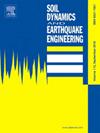用混合墙和冲击弹性隔震器改造的木结构建筑的抗震性能
IF 4.6
2区 工程技术
Q1 ENGINEERING, GEOLOGICAL
引用次数: 0
摘要
轻框架木结构建筑(LFTBs)由于其易于组装和预先合格的结构元件的可用性而被广泛应用于地震地区。然而,在极端事件期间,lftb容易受到崩溃机制的影响,例如软层故障。不同的研究侧重于通过构建结合木材和其他材料的混合元素来提高LFTB的横向抗力系统能力,以解决这一脆弱性。虽然这些混合建筑对地震的抵抗力更强,但它们的地板加速度也很大。另一方面,摩擦隔震已经证明了它在保护LFTBs和降低其地板加速度方面的有效性。然而,在极端地震期间,隔震器的周长环与滑块之间可能会发生冲击,从而降低隔震效果。针对这一现象,本文评估了典型建筑的抗震性能,这些建筑是智利房地产行业的代表,受到能够产生冲击的极端地面运动的影响。该分析包括在合并混合壁和最近开发的冲击弹性双凹摩擦摆(IR-DCFP)轴承后改装的LFTBs。考虑隔振器在极端位移作用下仍能正常工作,采用FEMA P695方法,对非线性模型进行增量动力分析,得到每个原型的崩溃边缘比,进而得到其易损性曲线。结果表明,结合混合墙和IR-DCFPs,即使考虑到低墙密度和紧凑轴承的使用,LFTB在最大考虑地震水平下的倒塌概率也降低了35%。这些发现表明,IR-DCFPs与混合墙相结合,为提高高地震活动性地区LFTBs的抗震能力提供了一种经济有效的解决方案。本文章由计算机程序翻译,如有差异,请以英文原文为准。
Seismic performance of timber buildings retrofitted with hybrid walls and impact-resilient isolators
Light-frame timber buildings (LFTBs) are widely used in seismic regions due to their ease of assembly and the availability of pre-qualified structural elements. However, LFTBs are susceptible to collapse mechanisms such as soft-story failures during extreme events. Different studies have focused on increasing the LFTB's lateral force-resisting system capacity to address this vulnerability by constructing hybrid elements combining wood with other materials. Although these hybrid buildings are more resistant to seismic forces, they have exhibited large floor accelerations. On the other hand, frictional seismic isolation has demonstrated its efficiency in protecting LFTBs and reducing their floor accelerations. However, during extreme earthquakes, an impact between the perimeter ring of the isolators and the sliders can occur, reducing the effectiveness of seismic isolation. In response to this phenomenon, this paper evaluates the seismic performance of archetype buildings, representative of the Chilean real estate sector, subjected to extreme ground motions capable of inducing impact. The analysis includes retrofitted LFTBs after incorporating hybrid walls and recently developed Impact-Resilient Double Concave Frictional Pendulum (IR-DCFP) bearings. Considering the isolators remain functional under extreme displacements and the FEMA P695 methodology, incremental dynamic analyses of nonlinear models were conducted to obtain the collapse margin ratio of each archetype and, subsequently, their fragility curves. Results indicated that incorporating hybrid walls and IR-DCFPs reduced the LFTB's probability of collapse at the Maximum Considered Earthquake level by up to 35 %, even considering a low wall density and the use of compact bearings. These findings suggest that IR-DCFPs combined with hybrid walls offer a cost-effective solution for improving the seismic resilience of LFTBs in high-seismicity regions.
求助全文
通过发布文献求助,成功后即可免费获取论文全文。
去求助
来源期刊

Soil Dynamics and Earthquake Engineering
工程技术-地球科学综合
CiteScore
7.50
自引率
15.00%
发文量
446
审稿时长
8 months
期刊介绍:
The journal aims to encourage and enhance the role of mechanics and other disciplines as they relate to earthquake engineering by providing opportunities for the publication of the work of applied mathematicians, engineers and other applied scientists involved in solving problems closely related to the field of earthquake engineering and geotechnical earthquake engineering.
Emphasis is placed on new concepts and techniques, but case histories will also be published if they enhance the presentation and understanding of new technical concepts.
 求助内容:
求助内容: 应助结果提醒方式:
应助结果提醒方式:


